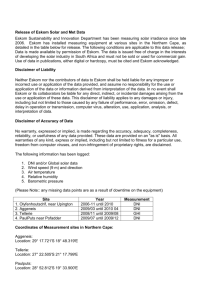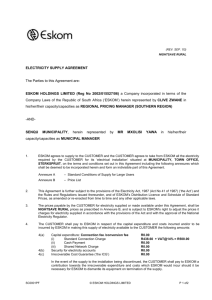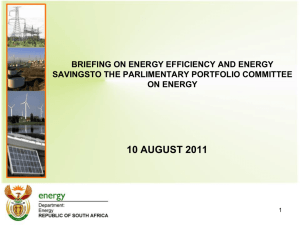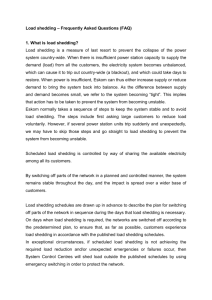EEDSM remains an option for addressing SA`s electricity crisis
advertisement
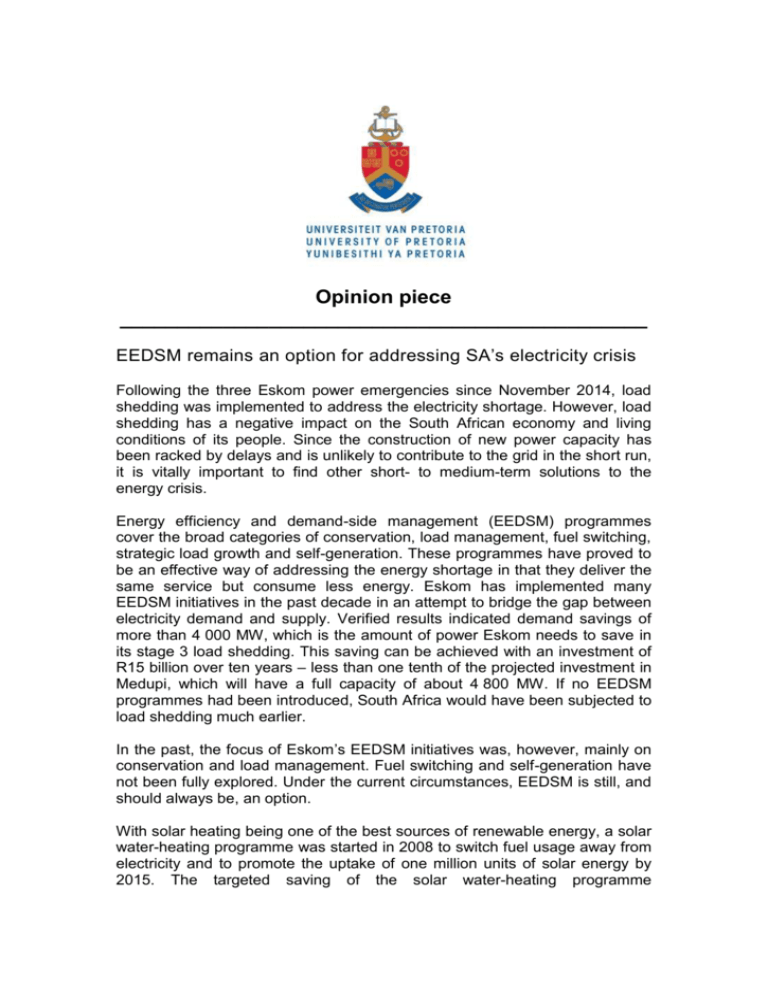
Opinion piece ______________________________________________ EEDSM remains an option for addressing SA’s electricity crisis Following the three Eskom power emergencies since November 2014, load shedding was implemented to address the electricity shortage. However, load shedding has a negative impact on the South African economy and living conditions of its people. Since the construction of new power capacity has been racked by delays and is unlikely to contribute to the grid in the short run, it is vitally important to find other short- to medium-term solutions to the energy crisis. Energy efficiency and demand-side management (EEDSM) programmes cover the broad categories of conservation, load management, fuel switching, strategic load growth and self-generation. These programmes have proved to be an effective way of addressing the energy shortage in that they deliver the same service but consume less energy. Eskom has implemented many EEDSM initiatives in the past decade in an attempt to bridge the gap between electricity demand and supply. Verified results indicated demand savings of more than 4 000 MW, which is the amount of power Eskom needs to save in its stage 3 load shedding. This saving can be achieved with an investment of R15 billion over ten years – less than one tenth of the projected investment in Medupi, which will have a full capacity of about 4 800 MW. If no EEDSM programmes had been introduced, South Africa would have been subjected to load shedding much earlier. In the past, the focus of Eskom’s EEDSM initiatives was, however, mainly on conservation and load management. Fuel switching and self-generation have not been fully explored. Under the current circumstances, EEDSM is still, and should always be, an option. With solar heating being one of the best sources of renewable energy, a solar water-heating programme was started in 2008 to switch fuel usage away from electricity and to promote the uptake of one million units of solar energy by 2015. The targeted saving of the solar water-heating programme (miscalculated as equivalent to the generating capacity of an average-sized power plant) was not achieved. The International Energy Agency, in its 2013 World energy outlook, reported that about half of the world’s energy demand is for heat. The situation in SA is no different. According to Eskom, 40% of electricity consumed by SA’s residential sector is used for heating water and 31% for operating kitchenware such as ovens, stoves and hotplates. According to a Japanese report, the SA industry demand for heat is estimated to constitute about 70% of the energy consumption in the industrial sector. An Eskom report states that the residential sector used 14 105 MW of Eskom’s output in 2013 while other sectors used an aggregated 25 160 MW. If the heat demand had been supplied by sources other than electricity, a staggering 19 060 MW (with the residential sector accounting for 7 052 MW) would have been saved. This is more than four times the demand of Eskom’s stage 3 load shedding. If the residential sector’s energy demand for water heating could be supplied by natural gas or coal gas, a total demand of 5 642 MW could be substituted on the utility grid, which will allow Eskom to meet the country’s power demands without load shedding. Currently, the heat demand in SA is supplied largely by electricity. However, conversion efficiency from coal to electricity and then to heat is much lower than direct conversion from coal or gas to heat. Eskom’s power plants have a marginal 35% efficiency, while that of direct conversion from coal or gas to heat can easily be more than 70%. Coal gasification plants are able to reach conversion efficiencies from coal to heat of around 75%, and from coal to gas and then to electricity of around 50%, which is by far the most efficient technology to generate heat and electricity from coal. While the capital cost of coal/gas/electricity technology, such as an integrated gasification combined cycle (IGCC), is about 25% higher than traditional coal-fired power plants, the semi-combustion process of coal gasification to satisfy the demand for heat is quite affordable. The cost of this process is less than half of Eskom’s current EEDSM benchmark of R5 million/MW, and the operational cost is about one third of that of a conventional power plant. In view of South Africa’s large coal reserves, clean coal gasification technology offers a very attractive option. Self-generation offers another short- to medium-term solution for SA’s electricity crisis. Using systems such as photovoltaics, wind turbines, cogeneration systems and gas-fired turbines to supply part or all of customers’ needs (heat/power) will provide a convenient way to reduce demand from the grid and consequently alleviate grid pressure and reduce transmission losses. Co-generation systems installed in industrial plants that produce high temperature waste heat, as well as captive power plants utilising biomass or gases, are good examples of self-generation. EEDSM remains the best option to alleviate the current crisis. In future, we must focus more on fuel switching to satisfy heat demand and also on selfgeneration. Prof Xia is the Director of the Centre of New Energy Systems (CNES) at the University of Pretoria.



